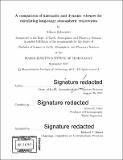| dc.contributor.advisor | Glenn R. Flierl. | en_US |
| dc.contributor.author | Schneider, Allison (Allison M.) | en_US |
| dc.contributor.other | Massachusetts Institute of Technology. Department of Earth, Atmospheric, and Planetary Sciences. | en_US |
| dc.date.accessioned | 2018-03-27T14:18:04Z | |
| dc.date.available | 2018-03-27T14:18:04Z | |
| dc.date.copyright | 2017 | en_US |
| dc.date.issued | 2017 | en_US |
| dc.identifier.uri | http://hdl.handle.net/1721.1/114336 | |
| dc.description | Thesis: S.B., Massachusetts Institute of Technology, Department of Earth, Atmospheric, and Planetary Sciences, 2017. | en_US |
| dc.description | Cataloged from PDF version of thesis. | en_US |
| dc.description | Includes bibliographical references (pages 57-58). | en_US |
| dc.description.abstract | Two numerical models, one kinematic and one dynamic, were created and compared in their ability to predict trajectories of atmospheric parcels over eight days. While kinematic models are more widely used due to their accuracy, dynamic models can be used pedagogically to visualize the balance of forces in the atmosphere. The kinematic model used gridded wind speed data from the Global Forecast System (GFS) to predict parcel flow, while the dynamic model calculated wind speeds from advection equations using geopotential height fields from GFS. The trajectories of ensembles of parcels were simulated from five launch locations. The spread of parcels from each location was calculated along with the deviation from reference trajectories. The dynamic model performed comparably to the kinematic model, despite the presence of inertial oscillations in some computed trajectories at mid- and high- latitudes which are likely to be physically unrealistic. The dynamic model was more sensitive to changes in spatial resolution than the kinematic model. Dynamic trajectory models were shown to be accurate enough to be used as a tool to visualize the interplay of forces acting in the atmosphere. | en_US |
| dc.description.statementofresponsibility | by Allison Schneider. | en_US |
| dc.format.extent | 58 pages | en_US |
| dc.language.iso | eng | en_US |
| dc.publisher | Massachusetts Institute of Technology | en_US |
| dc.rights | MIT theses are protected by copyright. They may be viewed, downloaded, or printed from this source but further reproduction or distribution in any format is prohibited without written permission. | en_US |
| dc.rights.uri | http://dspace.mit.edu/handle/1721.1/7582 | en_US |
| dc.subject | Earth, Atmospheric, and Planetary Sciences. | en_US |
| dc.title | A comparison of kinematic and dynamic schemes for calculating long-range atmospheric trajectories | en_US |
| dc.type | Thesis | en_US |
| dc.description.degree | S.B. | en_US |
| dc.contributor.department | Massachusetts Institute of Technology. Department of Earth, Atmospheric, and Planetary Sciences | |
| dc.identifier.oclc | 1028749244 | en_US |
